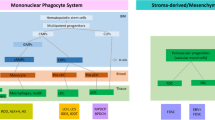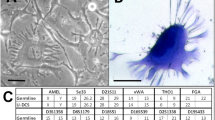Summary
Most pleomorphic adenomas were found to contain abundant dendritic cells (DC) with major histo-compatibility complex (MHC) class II (HLA-DR) expression. Their immunohistochemical staining features were suggestive of dendritic histiocytic cells. Extensive phenotypic characterization by two-colour immunofluorescence staining for various cell markers was performed. The DC expressed both HLA class I and II determinants, vimentin, S-100 protein, and various monocyte-related markers (10G11, 3D10, 7G5 or CD11a, 8C2) but were negative for leucocyte common antigen (CD45), Leu-6 (CD1), and the myelomonocytic L1 antigen. Characterization of HLA-DR positive DC isolated by an immunomagnetic bead method confirmed the immunohistochemical staining pattern that corresponds to the phenotype of interdigitating cells. Morphological and immunological implications of the abundant presence of these cells in pleomorphic adenomas are discussed.
Similar content being viewed by others
References
Adamson TC, Fox RI, Frisman DM, Howell FV (1983) Immunohistological analysis of lymphoid infiltrates in primary Sjögren’s syndrome using monoclonal antibodies. J Immunol 130:203–208
Brandtzaeg P (1974) Mucosal and glandular distribution of immunoglobulin components. Immunohistochemistry with cold ethanol-fixation technique. Immunology 26:1101–1114
Brandtzaeg P, Rognum TO (1983) Evaluation of tissue preparation methods and paired immunofluorescence staining for immunocytochemistry of lymphomas. Histochem J 15:655–689
Brandtzaeg P, Dale I, Fagerhol MK (1987) Distribution of a formalin-resistant myelomonocytic antigen (L1) in human tissues. I. Comparison with other leukocyte markers by paired immunofluorescence and immunoenzyme staining. Am J Clin Pathol 87:681–699
Dale I, Brandtzaeg P, Fagerhol MK, Scott H (1985) Distribution of a new myelomonocytic antigen (L1) in human peripheral blood leukocytes. Immunofluorescence and immunoperoxidase staining features in comparison with lysozyme and lactoferrin. Am J Clin Pathol 84:24–34
David R, Buchner A (1980) Langerhans’ cells in a pleomorphic adenoma of submandibular salivary gland. J Pathol 131:127–135
De Waal RMW, Semeijn JT, Cornelissen IMH, Ramaekers FCS (1984) Epidermal Langerhans cells contain intermediate-sized filaments of the vimentin type: an immunocytologic study. J Invest Dermatol 82:602–604
Delsol G, Al Saati T, Caveriviere P, Voigt JJ, Ancelin E, Rigal-Huguet F (1984) Immunoperoxidase study of normal and pathological lymphoid tissues: Advantages of monoclonal antibodies. Ann Pathol 4:165–183
Fithian E, Kung P, Goldstein G, Rubenfeld M, Fenoglio C, Edelson R (1981) Reactivity of Langerhans cells with hybridoma monoclonal antibody. Proc Natl Acad Sci USA 78:2541–2544
Fox RI, Bumol T, Fantozzi R, Bone R (1986) Expression of histocompatibility antigen HLA-DR by salivary gland epithelial cells in Sjögren’s syndrome. Arthritis Rheum 29:1105–1111
Hammar S, Bockus D, Remington F, Bartha M (1986) The wide-spread distribution of Langerhans cells in pathologic tissues: an ultrastructural and immunohistochemical study. Hum Pathol 17:894–905
Hoffman-Fezer G, Gotze D, Rodt H, Thierfelder S (1978) Immunohistochemical localization of xenogenic antibodies against Ia lymphocytes on B cells and reticular cells. Immunogenetics 6:367–377
Hsu S-M, Crossman J, Jaffe ES (1983) Lymphocyte subsets in normal human lymphoid tissues. Am J Clin Pathol 80:21–30
Huitfeldt HS, Brandtzaeg P (1985) Various keratin antibodies produce immunohistochemical staining of human myocardium and myometrium. Histochemistry 83:381–389
Inaba K, Schuler G, Witmer MD, Valinsky J, Atassi B, Steinman RM (1986) Immunologic properties of purified epidermal Langerhans cells. Distinct requirements for stimulation of unprimed and sensitized T lymphocytes. J Exp Med 164:605–613
Knight SC (1984) Veiled cells “dendritic cells” of the peripheral lymph. Immunobiology 168:349–361
Knight S, Hunt R, Dore C, Medawar PB (1985) Influence of dendritic cells on tumor growth. Proc Natl Acad Sci USA 82:4495–4497
Kraal G, Breel M, Janse M, Bruin G (1986) Langerhans’ cells, veiled cells, and interdigitating cells in the mouse recognized by a monoclonal antibody. J Exp Med 163:981–997
Lindahl G, Hedfors E, Klareskog L, Forsum U (1985) Epithelial HLA-DR expression and T lymphocyte subsets in salivary glands in Sjögren’s syndrome. Clin Exp Immunol 61:475–482
Mason DY (1985) Immunohistochemical labeling of monoclonal antibodies by the APAAP immunoalkaline phosphate technique. In: Bullock GR, Petrusz P (eds) Immunocytochemistry, vol 3. Academic Press, London, pp 25–42
Matthews JB, Potts AJC, Hamburger J, Scott DGI (1985) T6 antigen-positive cells in human labial salivary glands. Archs Oral Biol 30:325–329
McMillan EM, Brubaker DB, Peters S et al. (1983) Demonstration of cells bearing the OKT6 determinant in human tonsil and lymph node. Cancer Immunol Immunother 15:221–226
Mierau GW, Favara BE (1986) S-100 protein immunohistochemistry and electron microscopy in the diagnosis of Langerhans cell proliferative disorders: a comparative assessment. Ultrastruct Pathol 10:303–309
Moll R, Franke WW, Schiller DL, Geiger B, Krepier R (1982) The catalog of human cytokeratins: patterns of expression in normal epithelia, tumors and cultured cells. Cell 31:11–24
Mukai K, Rosai J, Burgdorf WHC (1980) Localization of factor VIII-related antigen in vascular endothelial cells using an immunoperoxidase method. Am J Surg Pathol 4:273–276
Murphy GF, Bhau AK, Sato S, Mihm MC, Harrist TJ (1981) A new immunologie marker for human Langerhans cells. N Engl J Med 304:781–792
Oxholm PO, Manthorpe R, Oxholm A, Schiödt M (1985) Brief report. Langerhans cells in labial minor salivary glands in primary Sjögren’s syndrome. Acta Pathol Microbiol Immunol Scand Sect A 93:105–107
Poppema S, Bhan AK, Reinherz EL, McClusky RT, Schlossman SF (1981) Distribution of T cell subsets in human lymph nodes. J Exp Med 153:30–41
Raphael M, Debre P, Charron DJ (1984) Reduced Ia-positive Langerhans’ cells in AIDS (letter). N Engl J Med 311:858
Reinherz EL, Rubenfeld M, Fenoglio C, Edelson R, Kung PC, Goldstein G, Levey RH, Schlossman SF (1980) Discrete stages of human intrathymic differentiation: Analysis of normal thymocyte and leukaemic lymphoblasts of T cell lineage. Proc Natl Acad Sci USA 77:1588–1592
Roop DP, Cheng CK, Toftgard R, Stanley JR, Steinert PM, Yuspa SH (1985) The use of cDNA clones and monospecific antibodies as probes to monitor keratin gene expression. Ann NY Acad Sci 455:426–435
Schuler G, Steinman RM (1985) Murine epidermal Langerhans cells mature into potent immunostimulatory dendritic cells in vitro. J Exp Med 161:526–546
Schuler G, Romani N, Steinman RM (1985) A comparison of murine epidermal Langerhans cells with spleen dendritic cells. J Invest Dermatol 85:99s-106s
Segerberg-Konttinen M, Bergroth V, Jungeil P, Malmstrom M, Nordström D, Sane J, Immonen I, Konttinen YT (1987) T lymphocyte activation state in the minor salivary glands of patients with Sjögren’s syndrome. Annals Rheum Dis 46:649–653
Skoskiewicz MJ, Colvin RB, Schneeberger EE, Russel PS (1985) Widespread and selective induction of major histocompatibility complex-determined antigens in vivo by gamma interferon. J Exp Med 162:1645–1664
Steinman RM, Nussenzweig MC (1980) Dendritic cells: features and functions. Immunol Rev 53:127–147
Takahashi K, Isobe T, Ohtsuki Y, Sonobe H, Takeda I, Akagi T (1984) Immunohistochemical localization and distribution of S-100 proteins in human lymphoreticular system. Am J Pathol 116:497–503
Thrane PS, Roop DR, Sollid LM, Huitfeldt HS, Brandtzaeg P (1990) Two-colour immunofluorescence marker study of pleomorphic adenomas. Histochemistry 93:459–468
Thrane PS, Rognum TO, Huitfeldt HS, Brandtzaeg P (1987) The distribution of HLA-DR determinants, secretory component (SC), amylase, lysozyme, IgA, IgM, and IgD in fetal and postnatal salivary glands. Adv Exp Med Biol 216B: 1431–1438
Vaines K, Brandtzaeg P (1985) Retardation of immunfluorescence fading during microscopy. J Histochem Cytochem 83:381–389
Van der Oord JJ, De Wolf-Peeters C, Desmet VJ, Takahashi K, Ohtsuki Y, Akagi T (1985) Nodular alteration of the paracortical area. An in situ immunohistochemical analysis of primary, secondary, and tertiary T-nodules. Am J Pathol 120:55–66
Vartdal F, Gaudernack G, Funderud S, Bratlie A, Lea T, Ugelstad J, Thorsby E (1986) HLA class I and II typing using cells positively selected from blood by immunomagnetic isolation-a fast and reliable technique. Tissue Antigens 28:301–312
Watamabe S, Nakajima T, Shimosato Y, Shimamura K, Sakuma H (1983) T-zone histiocytes with S100 protein. Development and distribution in human fetuses. Acta Pathol Jpn 33:15–22
Author information
Authors and Affiliations
Rights and permissions
About this article
Cite this article
Thrane, P.S., Sollid, L.M. & Brandtzaeg, P. Abundant dendritic cells express HLA-DR in pleomorphic adenomas. Virchows Archiv B Cell Pathol 59, 195–203 (1990). https://doi.org/10.1007/BF02899405
Received:
Accepted:
Issue Date:
DOI: https://doi.org/10.1007/BF02899405




